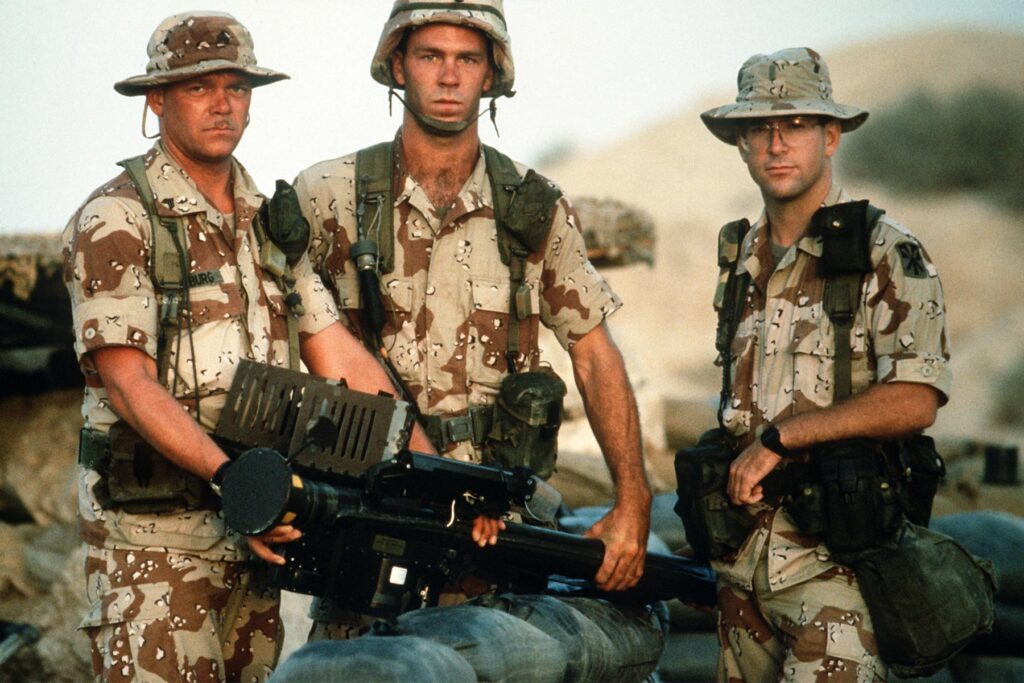
The Desert Battle Dress Uniform (DBDU) was the combat uniform worn by the United States Armed Forces in arid and desert environments from the early 1980s through the early 1990s. Known for its distinctive “chocolate-chip” camouflage pattern, the DBDU was designed to provide effective concealment in desert conditions. Here’s a detailed look at the DBDU, covering its development, features, deployment, and legacy:
Development and Introduction
Background
- Need for Desert Camouflage: In the late 1970s, the U.S. military identified the need for a specialized uniform suited to desert operations, as existing camouflage patterns were inadequate for arid environments.
- Development Process: The DBDU was developed to meet this need, with the camouflage pattern designed to blend with the varied colors and textures of desert terrain.
Design and Testing
- Pattern Design: The DBDU’s camouflage pattern was a six-color design featuring dark brown, light brown, tan, black, white, and a distinctive “cookie dough” base. The pattern included black spots that resembled chocolate chips, giving it the nickname “chocolate-chip” camouflage.
- Field Testing: The uniform underwent testing in desert environments to evaluate its effectiveness in providing concealment and functionality for soldiers operating in these conditions.
Features of the DBDU
Camouflage Pattern
- Six-Color Design: The six-color pattern was intended to replicate the appearance of rocky, sandy, and scrubby desert terrain. The black and white spots were meant to mimic the shadows and highlights of rocky surfaces.
Uniform Components
- Material: The DBDU was made from a heavy cotton blend, which provided durability but was not ideal for the high temperatures typically encountered in desert environments.
- Design: The DBDU followed the design of the Battle Dress Uniform (BDU), with a few modifications to suit desert conditions:
- Jacket: Features included a button-front closure, two chest pockets, and two lower pockets, all with button flaps. The jacket also had adjustable cuffs.
- Trousers: Included an adjustable waistband, reinforced knees and seat, and cargo pockets with button closures.
- Headgear: The uniform was typically worn with a matching boonie hat or patrol cap, made in the same six-color pattern.
Deployment and Usage
Initial Adoption
- Early 1980s: The DBDU was officially adopted in the early 1980s and was used by U.S. military personnel during training exercises in desert environments.
- Widespread Use: The uniform saw extensive use during operations in the Middle East, particularly during the Gulf War in 1990-1991.
Performance in Combat
- Effectiveness in Desert Conditions: The DBDU was initially effective in certain desert terrains, providing good concealment in rocky and sandy environments. However, it was less effective in more uniform, sandy deserts where the pattern’s complexity was unnecessary.
- Heat Retention Issues: The heavy cotton material, while durable, was not ideal for high-temperature environments, leading to discomfort and overheating for soldiers.
Transition and Replacement
Emergence of the DCU
- Desert Camouflage Uniform (DCU): In the early 1990s, the U.S. military began developing the Desert Camouflage Uniform (DCU) to replace the DBDU. The DCU featured a simpler three-color pattern, which was more effective across a wider range of desert environments.
- Phased Replacement: The DCU gradually replaced the DBDU throughout the 1990s, becoming the standard desert uniform for U.S. forces.
Legacy and Impact
Lessons Learned
- Importance of Environment-Specific Camouflage: The DBDU’s effectiveness in certain environments and limitations in others highlighted the need for camouflage patterns tailored to specific operational conditions.
- Material Considerations: The issues with heat retention underscored the importance of selecting materials suited to the climate in which the uniform will be worn.
Influence on Future Uniforms
- Design Improvements: The transition from the DBDU to the DCU and subsequent uniforms incorporated lessons learned regarding pattern complexity and material suitability.
- Enhanced Testing and Feedback: The experience with the DBDU emphasized the need for extensive field testing and feedback from soldiers to ensure new uniforms meet operational needs effectively.
Conclusion
The Desert Battle Dress Uniform (DBDU) represented a significant step in the evolution of U.S. military camouflage, tailored specifically for desert warfare. While it had its strengths in certain terrains, its limitations in others and issues with heat retention led to its replacement by the more versatile Desert Camouflage Uniform (DCU). The DBDU’s development and deployment provided valuable insights that influenced the design of future military uniforms, highlighting the ongoing need for adaptability and suitability in combat gear.